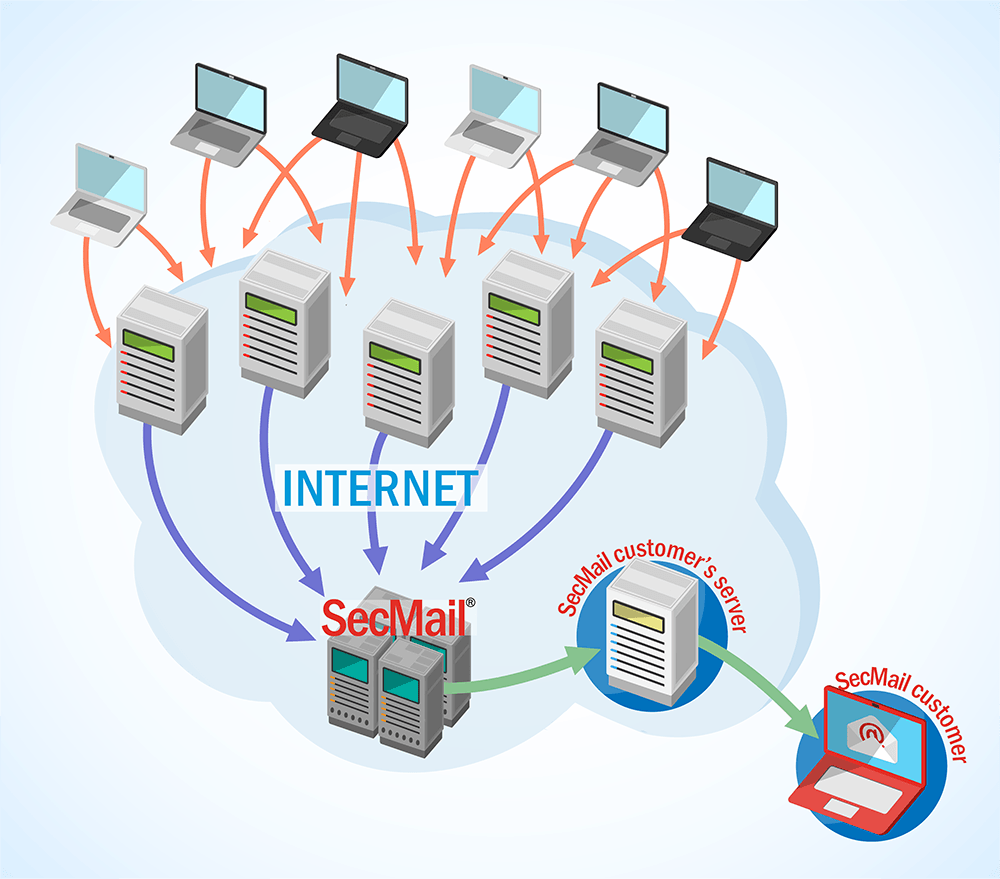Spam prevention
Due to generally large amounts of incoming spam, organizations and employees loose a considerably long time daily filtering important mail from the unwanted. This costs organizations large amounts of money weekly, let alone annually. As a filtering service helps the user to sort incoming email into different folders, SecMail® Email Security blocks all unwanted email already during the transmission process before they reach the recipients inbox. Hereafter, normally functioning email servers bounce the blocked spam back to the sender followed by a delivery block message with SecMail®'s error description and instructions for requesting to cancel a potentially unjustified blocking. With SecMail®'s unique approach, the user does not need a separate junk mail box nor will messages ever disappear mysteriously.
SecMail® blocks spam already in the transmission process

Different types of spam
Traditional spam
Traditionally, spam is perceived to be an email from abroad, where a short message prompts the receiver to click to a website and order a specific item. Often these emails keep multiplying, are disturbing and even scamming by deliberately delivering the customer something different from what they ordered. In the recent history, this type of email spam has been quite effective and the pioneers of spam actually made huge amounts of money by marketing and selling products over email.
The Nigerian letters are a good example of email scam from the past decades: The recipient of the letter was asked to pay a 'small handling fee' and in exchange he was promised to receive a large commission on a foreign money transfer. Basically what happened was the 'handling fees' disappeared and the commissions were never paid. Nowadays these types of messages aren't quite so effective anymore. Email users are more aware of the threats of spam, but on the other hand the spammers invent something new every day.
Modern spam
Spammers have developed their approaches and the definition for spam has become more or less unclear. These days spam mostly consists of marketing emails and advertisements sent to masses of people, without having recipients' permissions and recipients hardly even belonging to the actual target group of the campaign. Often email addresses for these mass mailings are collected from some specific register where users have input their details for some completely different purpose, or they are stolen by a spammer hacking in to such data register. There are also several services selling customer data such as email addresses, which can be used in good conduct and targeting the mailings carefully. However, also the mailings using bought data turn out to be spam if the targeting of the email campaign is done poorly and the campaign reaches people who don't belong in the specific interest group.
It's a fine line between junk mail and marketing mail - each of us experiences them differently. Often marketing emails become spam, because the senders do their background checking poorly. Drawing the line between junk mail and marketing mail is extremely case dependent and very often a personal matter. Sometimes, a person who receives only a few emails daily doesn't get annoyed of having a couple of junk mails in the mix, but a person receiving a large number of urgent emails daily might get quite irritated of any unnecessary mailings.
Marketing emails and courtesy
A huge portion of today's email traffic consists of marketing messages. Advertisers operating with good conduct, let recipients unsubscribe from their mailing register after having received a marketing message. In the best case scenario, unsubscribing is made easy, for example clicking a link activates the unregistration. However, in some cases unsubscribing has been made difficult or almost impossible: to cancel the spamming the recipient can be expected to draw up a separate email request or fill in complicated forms. Due to generally large amounts of incoming spam, the withdrawal effort may cost the recipient a considerably long time weekly.
SecMail® Email security to the rescue
Prevent Emails Containing Viruses and Harmful Contents
All of SecMail® users' incoming email traffic is transferred through the hardware and connections of the effective and highly verified SecMail® system. The system blocks all traditional spam and emails containing harmful programs with the accuracy of nearly 100 %.
Prevent unwanted advertisements, polls and marketing email
Using the SecMail Email Security service, the user can specify whether mass mailings are generally welcome or not. Having received an unwanted mass mailing, the user can also through the simple and user-friendly SecMail® interface effortlessly inform the service about not wanting to receive such mailings in the future. The system then starts the blocking and begins to identify similar mailings as spam in the email systems of all other SecMail® users too. In other words, users' spam notifications help SecMail® detect and block spam in all user accounts.
Furthermore, the user organization or alternatively single users determine their own specific guidelines regarding the receiving of borderline spam and clear marketing or poll mailings. In the end, only wanted mailings will clear through and find their way to the receiving mail server and to the recipients' inboxes.
Prevent unnecessary system investments
SecMail® reducing the unwanted traffic significantly improves the organization's own mail system's performance, which spares the organization from unnecessary investments.
 Suomeksi
Suomeksi

 SecMail on Twitter
SecMail on Twitter